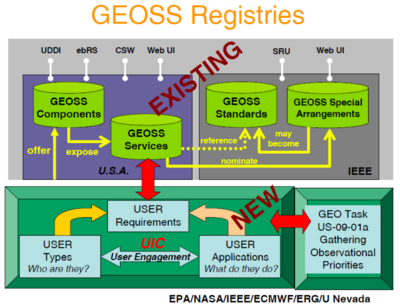User Requirement Registry
From Earth Science Information Partners (ESIP)
Revision as of 01:26, March 14, 2010 by Rhusar (talk | contribs) (→User Requirements Registry Features)
< GEO User Requirements for Air Quality | Report | Documents | Resources
User Requirements Registry Features
- A “user engagement” entry point for the Novice Users coming to the GEO Home Page
- Initially populated from the US-09-01a reports
- Shares info on registered types, applications and requirements; allows users to comment
- Allows users to register their type, applications, and requirements
- A standard vocabulary/ontology for use in registration
- Provides requirements for “Gap Analysis”
User Classes for Air Quality (Gary Foley)
- Public Information Delivery
- Public Emergency & Health Officials
- Operational Modeling Forecasting
- Local & Regional Environmental managers
- Earth Observation Community
Activities of Each User Class
Activities
- Participate in monthly calls of the Analysts
- Two face-to-face meetings of the Analysts
- Assist with developing concepts and approaches for cross-cutting analyses of the observational priorities and other important information from the 2009 US-09-01a primary reports.
- Conduct further analyses of the area of the Health SBA that would further this cross-cutting effort.
- Engage the AG
- Replace members, as needed.
- Ensure that the AG members have access to the primary and secondary products, as appropriate.
- Database of keywords for the Health SBA area using the 2009 US-09-01a report as the source material for the keywords.
- Populating the User Requirements Registry (URR) and databases with the appropriate information from the primary and secondary products of the 2009 work.
- Conduct an international GEO workshop in the aeroallergens area of the Health SBA jointly with other sponsors to
- engage users
- engage observation providers
- support new Communities of Practice
- present the results of this task
- further populate the URR
- share new GEO-relevant scientific and technical results
- identify voluntary efforts to initiate additional activities, etc.
